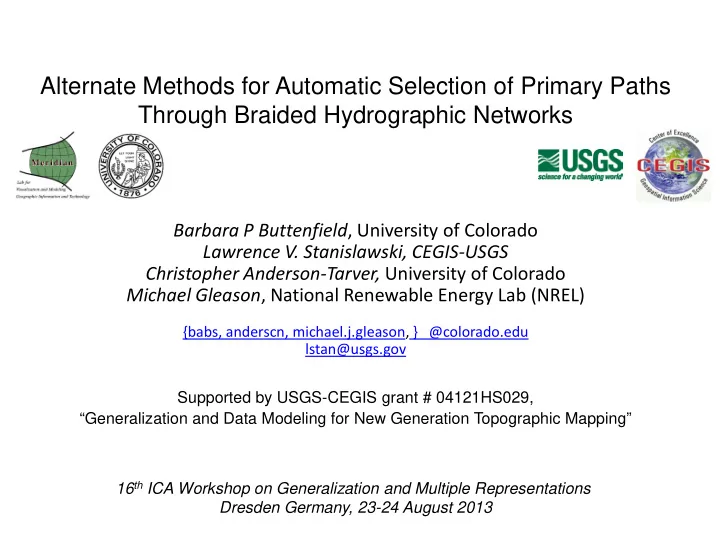

Alternate Methods for Automatic Selection of Primary Paths Through Braided Hydrographic Networks Barbara P Buttenfield , University of Colorado Lawrence V. Stanislawski, CEGIS-USGS Christopher Anderson-Tarver, University of Colorado Michael Gleason , National Renewable Energy Lab (NREL) {babs, anderscn, michael.j.gleason, } @colorado.edu lstan@usgs.gov Supported by USGS-CEGIS grant # 04121HS029, “Generalization and Data Modeling for New Generation Topographic Mapping” 16 th ICA Workshop on Generalization and Multiple Representations Dresden Germany, 23-24 August 2013
Why delineate primary paths? • Primary channels contain the most water – useful for topographic base mapping and hydrological analysis • Automatic methods often based on stream order. • Automated methods difficult with High Resolution (24K) NHD (National Hydrography Dataset) – Stream order not explicitly coded, due to database size and irregular update cycle – Prioritize stream channels by Upstream Drainage Area (UDA )
Basic Delineation Algorithm – Stage 1 1. Establish primary path “stems” -- select on UDA
Basic Delineation 2. Trace path upstream from each “stem” to headwaters At each confluence, select a primary channel as follows: a. If one tributary shares Reachcode of downstream flowline, select it ELSE b. If one tributary shares GNIS Name of downstream flowline select it ELSE c. If neither/both tributaries share Reachcode/GNIS name … select the tributary with greater UDA value a. b. c.
Results of Basic Delineation – Stage 1 Lower Prairie Dog Town Fork Red River, Texas HUC8: 11120105 LIMITATION OF BASIC SOLUTION • Including all braided channels can produce overly complex primary path • Following basic identification, delineate one or several paths through the braid to prioritize channels or to clarify map display
Solution 1: Inner Channel Algorithm • Isolate a set of braided channels • Convert flowlines to polygons • Dissolve; select flowlines contained in braid polygons • Work upstream from the outflow channel of each braid polygon • Use the same basic delineation rules at confluences to trace single primary path through braid 1. Reachcode ID match When multiple inflows contribute to a braid, isolate new braid polygon and 2. GNIS Name match delineate primary channel using 3. Highest UDA same basic delineation rules
Solution 2: Outer Channel Algorithm • Rationale – In some mapping situations, knowledge of braid extent as important as the primary channel • Useful for small scale mapping – Use longstanding cartographic convention applied to rail sidings • Retain outermost tracks to preserve overall shape / extent McMaster and Shea 1992: 60
Results Solution 1 Inner Channel Solution 2 Outer Channel
Algorithm Comparison All Channels ~ 24k -100K Outer Channel ~ 1M Inner Channel
Solution 3: Weighted Channel Algorithm Rank all flowline channels in braid polygon; display progressive subsets at intermediate scales
(wts 1-60) All Paths (wts 6-60) Lose terminal channels (wts 13-60) Lose most internal connector channels (wts 18-60) Identical to Inner Channel solution
Summary of Weighted Channel Progress • Modified railroad siding analogy – Prioritizes braid extent & primary channel(s) – Protects channel connectivity Slocum et al 2009 – Continuous scale progression, no flicker Thematic Cartography : 102 – Braid weights as surrogate for stream order – Delineating primary channels instead of pruning data for large scale jumps – ICC paper Thursday • Ongoing Tasks – Associate weights with specific scale ranges – Test other weighting schemes, larger braids, larger scale ranges Courtesy Juan Solarzano http://www.youtube.com/watch?v=I8-_ffXGpQk
NHD 10200101 Middle Platte-Buffalo Rivers, Nebraska (wts 2-60) All Paths (wts 9-60) Lose terminal channels (wts 13-60) Lose canals, ditches, irrigation pipelines But not quite identical to Inner / Outer Channel solutions
Recommend
More recommend